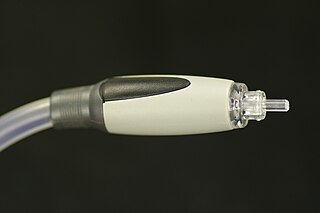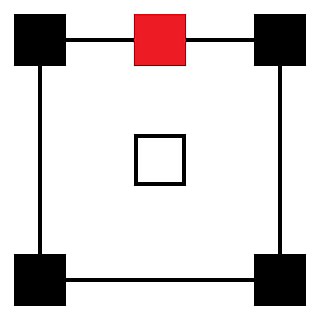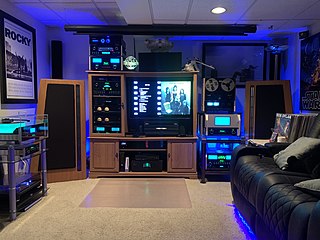Dolby Digital, originally synonymous with Dolby AC-3, is the name for a family of audio compression technologies developed by Dolby Laboratories. Called Dolby Stereo Digital until 1995, it is lossy compression. The first use of Dolby Digital was to provide digital sound in cinemas from 35 mm film prints. It has since also been used for TV broadcast, radio broadcast via satellite, digital video streaming, DVDs, Blu-ray discs and game consoles.

S/PDIF is a type of digital audio interface used in consumer audio equipment to output audio over relatively short distances. The signal is transmitted over either a coaxial cable using RCA or BNC connectors, or a fiber-optic cable using TOSLINK connectors. S/PDIF interconnects components in home theaters and other digital high-fidelity systems.

Home cinema, also called home theaters or theater rooms, are home entertainment audio-visual systems that seek to reproduce a movie theater experience and mood using consumer electronics-grade video and audio equipment that is set up in a room or backyard of a private home. Some studies show that films are rated better and generate more intense emotions when watched in a movie theater, but convenience is a major appeal for home cinemas. In the 1980s, home cinemas typically consisted of a movie pre-recorded on a LaserDisc or VHS tape; a LaserDisc Player or VCR; and a heavy, bulky large-screen cathode ray tube TV set, although sometimes CRT projectors were used instead. In the 2000s, technological innovations in sound systems, video player equipment and TV screens and video projectors have changed the equipment used in home cinema set-ups and enabled home users to experience a higher-resolution screen image, improved sound quality and components that offer users more options. The development of Internet-based subscription services means that 2020s-era home theatre users do not have to commute to a video rental store as was common in the 1980s and 1990s.

Sound Blaster is a family of sound cards and audio peripherals designed by Singaporean technology company Creative Technology. The first Sound Blaster card was introduced in 1989.

A mixing console or mixing desk is an electronic device for mixing audio signals, used in sound recording and reproduction and sound reinforcement systems. Inputs to the console include microphones, signals from electric or electronic instruments, or recorded sounds. Mixers may control analog or digital signals. The modified signals are summed to produce the combined output signals, which can then be broadcast, amplified through a sound reinforcement system or recorded.

Surround sound is a technique for enriching the fidelity and depth of sound reproduction by using multiple audio channels from speakers that surround the listener. Its first application was in movie theaters. Prior to surround sound, theater sound systems commonly had three screen channels of sound that played from three loudspeakers located in front of the audience. Surround sound adds one or more channels from loudspeakers to the side or behind the listener that are able to create the sensation of sound coming from any horizontal direction around the listener.
Nakamichi Corp., Ltd. is a Japanese consumer electronics brand that originated in Japan and gained a name from the 1970s onwards for innovative and high quality audio cassette decks. Nakamichi is a subsidiary of Chinese holding company Nimble Holdings.
Dolby Pro Logic is a surround sound processing technology developed by Dolby Laboratories, designed to decode soundtracks encoded with Dolby Surround. The terms Dolby Stereo and LtRt are also used to describe soundtracks that are encoded using this technique.

Dolby Laboratories, Inc. is a British-American technology corporation specializing in audio noise reduction, audio encoding/compression, spatial audio, and HDR imaging. Dolby licenses its technologies to consumer electronics manufacturers.

DTS, Inc. is an American company. DTS company makes multichannel audio technologies for film and video. Based in Calabasas, California, the company introduced its DTS technology in 1993 as a competitor to Dolby Laboratories, incorporating DTS in the film Jurassic Park (1993). The DTS product is used in surround sound formats for both commercial/theatrical and consumer-grade applications. It was known as The Digital Experience until 1995. DTS licenses its technologies to consumer electronics manufacturers.
Dolby Digital Plus, also known as Enhanced AC-3, is a digital audio compression scheme developed by Dolby Labs for the transport and storage of multi-channel digital audio. It is a successor to Dolby Digital (AC-3), and has a number of improvements over that codec, including support for a wider range of data rates, an increased channel count, and multi-program support, as well as additional tools (algorithms) for representing compressed data and counteracting artifacts. Whereas Dolby Digital (AC-3) supports up to five full-bandwidth audio channels at a maximum bitrate of 640 kbit/s, E-AC-3 supports up to 15 full-bandwidth audio channels at a maximum bitrate of 6.144 Mbit/s.

Lexicon is an American company that engineers, manufactures, and markets audio equipment as a brand of Harman International Industries. The company was founded in 1971 with headquarters in Waltham, Massachusetts, and offices in Salt Lake City, Utah. It was acquired by Harman in 1993.

Sound Blaster Live! is a PCI add-on sound card from Creative Technology Limited for PCs. Moving from ISA to PCI allowed the card to dispense with onboard memory, storing digital samples in the computer's main memory and then accessing them in real time over the bus. This allowed for a much wider selection of, and longer playing, samples. It also included higher quality sound output at all levels, quadrophonic output, and a new MIDI synthesizer with 64 sampled voices. The Live! was introduced in August 1998 and variations on the design remained Creative's primary sound card line into the early 2000's.

An audio/video receiver (AVR) is a consumer electronics component used in a home theater. Its purpose is to receive audio and video signals from a number of sources, and to process them and provide power amplifiers to drive loudspeakers and route the video to displays such as a television, monitor or video projector. Inputs may come from a satellite receiver, radio, DVD players, Blu-ray Disc players, VCRs or video game consoles, among others. The AVR source selection and settings such as volume, are typically set by a remote controller.

DTS-HD Master Audio is a multi-channel, lossless audio codec developed by DTS as an extension of the lossy DTS Coherent Acoustics codec. Rather than being an entirely new coding mechanism, DTS-HD MA encodes an audio master in lossy DTS first, then stores a concurrent stream of supplementary data representing whatever the DTS encoder discarded. This gives DTS-HD MA a lossy "core" able to be played back by devices that cannot decode the more complex lossless audio. DTS-HD MA's primary application is audio storage and playback for Blu-ray Disc media; it competes in this respect with Dolby TrueHD, another lossless surround format.
Yamaha Pro Audio, Inc. is a division of the Yamaha Corporation that offers a complete line of beginner professional audio products for the live sound and sound reinforcement markets. It has a long history of introducing significant products for the professional audio market such as the PM-1000 modular mixing console, the REV1 and SPX90 digital signal processors, the NS-10 studio monitors, and the 01v, 02R, 03D, PM1D, PM5D, QL5, M7CL, CL5, and PM10/7 Rivage digital mixing consoles.

Center channel refers to an audio channel common to many surround sound formats. It is the channel that is mostly, or fully, dedicated to the reproduction of the dialogue of an audiovisual program. The speaker(s) connected to the center channel are placed in the center of and behind the perforated projection screen, to give the effect that sounds from the center channel are coming from the screen. In many home surround sound units, the center channel is positioned above or below the video screen.

Home audio systems refer to audio consumer electronics designed for home entertainment, such as integrated systems like shelf stereos and music centers, as well as individual components like loudspeakers and surround sound receivers. The evolution of home audio began with Edison's phonograph, transitioning from monaural to stereophonic sound in the 1950s and 60s. The term "hi-fi" emerged, highlighting sound accuracy and minimal distortion. Audio equipment evolved from large wooden cabinets to compact units. The 1970s introduced enhancements like quadraphonic sound and technologies like Dolby Pro Logic. The 1970s and 1980s also saw the rise of component-based stereo systems. Cassette decks became a staple in the 1970s. Integrated systems, termed "music centers" gained popularity in the 1980s. Table systems and compact radio receivers emerged as entertainment devices, with some offering features like cassette players and CD functionalities. Audiophile systems prioritize high-quality music formats and specialized equipment like premium turntables, digital-to-analog converters, and other high-end devices, with some enthusiasts preferring the unique sound characteristics of vinyl records and vacuum tubes. Modern systems often emphasize home cinema applications to enhance the audio experience beyond standard TV speakers.
Dolby Atmos is a surround sound technology developed by Dolby Laboratories. It expands on existing surround sound systems by adding height channels, allowing sounds to be interpreted as three-dimensional objects with neither horizontal nor vertical limitations. Following the release of Atmos for the cinema market, a variety of consumer technologies have been released under the Atmos brand, using in-ceiling and up-firing speakers.











